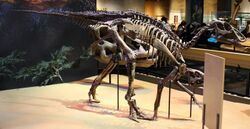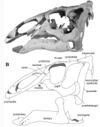Biology:Edmontosaurus kuukpikensis
| Edmontosaurus kuukpikensis | |
|---|---|

| |
| Reconstructed skeleton, Perot Museum | |
| Scientific classification | |
| Domain: | Eukaryota |
| Kingdom: | Animalia |
| Phylum: | Chordata |
| Clade: | Dinosauria |
| Clade: | †Ornithischia |
| Clade: | †Ornithopoda |
| Family: | †Hadrosauridae |
| Subfamily: | †Saurolophinae |
| Genus: | †Edmontosaurus Lambe, 1917 |
| Species: | †E. kuukpikensis
|
| Binomial name | |
| †Edmontosaurus kuukpikensis Mori et al., 2015
| |
| Synonyms | |
| |
Edmontosaurus kuukpikensis is a dubious species of saurolophine hadrosaurid which was found in the Arctic of Alaska. It was previously considered the distinct genus Ugrunaaluk.[1]
From the 1980s onwards, in Alaska more than six thousand bones of hadrosaurid dinosaurs were uncovered, at the Colville River. They were found north of Umiat in the Liscomb bonebed. At first they were identified as belonging to some member of the Lambeosaurinae.[2] Later, they were referred to Edmontosaurus, more specifically Edmontosaurus regalis, a member of the Saurolophinae.[3] A definite identification was hampered by the fact that most of the bones were of juveniles. In 2014, Hirotsugu Mori solved this problem by statistically determining size classes within the fossil material and comparing the Alaskan bones with known Edmontosaurus annectens specimens of the same size. He concluded that they represented two separate species.[1]
The Liscomb material was later named as the new genus Ugrunaaluk. The discovery of the new genus was published online on 22 September 2015 by Hirotsugu Mori, Patrick Druckenmiller and Gregory Erickson. Its name is derived from the Inupiat words for 'ancient grazer'.[1] Ugrunaaluk was one of eighteen dinosaur taxa from 2015 to be described in open access or free-to-read journals.[4] However, the identification of Ugrunaaluk as a separate genus was questioned by a 2017 study from Hai Xing and colleagues, who regarded it as a nomen dubium indistinguishable from other Edmontosaurus.[5] A 2020 study by Ryuji Takasaki and Anthony Fiorillo et. al. suggested adult material was needed to determine its validity, as the juvenile remains were undiagnostic within Edmontosaurus.[6]
References
- ↑ 1.0 1.1 1.2 Mori, Hirotsugu; Druckenmiller, Patrick S.; Erickson, Gregory M. (2015). "A new Arctic hadrosaurid from the Prince Creek Formation (lower Maastrichtian) of northern Alaska". Acta Palaeontologica Polonica 61. doi:10.4202/app.00152.2015. https://www.app.pan.pl/article/item/app001522015.html.
- ↑ Brouwers, E.M.; Clemens, W.A.; Spicer, R.A.; Ager, T.A.; Carter, L.D.; Sliter, W.V. (1987). "Dinosaurs on the North Slope, Alaska: High latitude, latest Cretaceous environments". Science 237 (4822): 1608–1610. doi:10.1126/science.237.4822.1608. PMID 17834451. Bibcode: 1987Sci...237.1608B.
- ↑ Xing, H.; Zhao, X.; Wang, K. Li; Chen, S.; Jordan, C.M.; Zhang, Y; Xu, X. (2014). "Comparative Osteology and Phylogenetic Relationship of Edmontosaurus and Shantungosaurus (Dinosauria: Hadrosauridae) from the Upper Cretaceous of North America and East Asia". Acta Geologica Sinica 88 (6): 1623–1652. doi:10.1111/1755-6724.12334.
- ↑ "The Open Access Dinosaurs of 2015". PLOS Paleo. http://blogs.plos.org/paleocomm/2016/01/06/the-open-access-dinosaurs-of-2015/.
- ↑ Xing, H.; Mallon, J.C.; Currie, M.L. (2017). "Supplementary cranial description of the types of Edmontosaurus regalis (Ornithischia: Hadrosauridae), with comments on the phylogenetics and biogeography of Hadrosaurinae". PLOS ONE 12 (4): e0175253. doi:10.1371/journal.pone.0175253. PMID 28384240. Bibcode: 2017PLoSO..1275253X.
- ↑ Takasaki, Fiorillo, Tykoski, Kobayashi, Ryuji, Anthony R., Ronald S., and Yoshitsugu (May 6, 2020). "Re-examination of the cranial osteology of the Arctic Alaskan hadrosaurine with implications for its taxonomic status". PLOS One. https://doi.org/10.1371/journal.pone.0232410.
Wikidata ☰ Q21006710 entry


